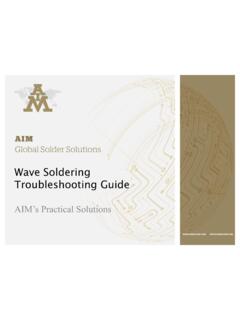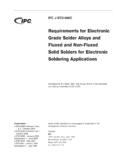Transcription of Stencil Design Guidelines for Electronics Assembly ...
1 BUDAPEST UNIVERSITY OF TECHNOLOGY AND ECONOMICSDEPARTMENT OF Electronics TECHNOLOGYS tudent professional contest The 22nd Edition, Brasov,24th-27th April 2013 Stencil Design Guidelines forElectronics Assembly TechnologiesREFLOW soldering - MATERIALO. Krammer: Stencil manufacturing and designSolder paste is a combination of pre-alloyed spherical metal powder andflux pastePacking of solder pastes: jar and syringeSolder pastehttp://engw Senj u2/44 REFLOW soldering TECHNOLOGYThe reflow soldering technology basicallyconsists of three steps:1. deposition of the solder pasteby dispensing (topic )or by Stencil printing2. placement of the componentspick&place, collect&place,3. remelting the solder alloy in the solder paste usually in an Krammer: Stencil manufacturing and designSurface mounted resistor3/44 REFLOW soldering TECHNOLOGYO.
2 Krammer: Stencil manufacturing and design4/44 The reflow soldering technology basicallyconsists of three steps:1. deposition of the solder pasteby dispensing (topic )or by Stencil printing2. placement of the componentspick&place, collect&place,3. remelting the solder alloy in the solder paste usually in an mounted resistorREFLOW soldering TECHNOLOGYO. Krammer: Stencil manufacturing and design5/44 The reflow soldering technology basicallyconsists of three steps:1. deposition of the solder pasteby dispensing (topic )or by Stencil printing2. placement of the componentspick&place, collect&place,3. remelting the solder alloy in the solder paste usually in an mounted resistorTHE Stencil PRINTINGT hestencilapplied for depositing the solder paste is a thin, 75 200 mthickmetal foil,on whichapertures are formedaccording to the solderpads on the printed circuit printingprovides a fast, masssolder paste deposition process.
3 Relatively expensive, appropriate andrecommended for mass Krammer: Stencil manufacturing and designsqueegeesolder pastestencil foilstencil framecircuit boardsoldering padstencil aperture6/44 PROCESS OF Stencil PRINTINGT hestencilapplied for depositing the solder paste is a thin, 75 200 mthickmetal foil,on whichapertures are formedaccording to the solderpads on the printed circuit printingprovides a fast, masssolder paste deposition process; relatively expensive, appropriate andrecommended for mass Krammer: Stencil manufacturing and designsqueegeesolder pastestencilfoilstencil framestencil aperture1. Aligning board to the stencil7/44 PROCESS OF Stencil PRINTINGT hestencilapplied for depositing the solder paste is a thin, 75 200 mthickmetal foil,on whichapertures are formedaccording to the solderpads on the printed circuit printingprovides a fast, masssolder paste deposition process; relatively expensive, appropriate andrecommended for mass Krammer: Stencil manufacturing and design2.
4 Moving squeegee on the Stencil filling aperturesv- speedF- forcerolling of paste8/44 PROCESS OF Stencil PRINTINGT hestencilapplied for depositing the solder paste is a thin, 75 200 mthickmetal foil,on whichapertures are formedaccording to the solderpads on the printed circuit printingprovides a fast, masssolder paste deposition process; relatively expensive, appropriate andrecommended for mass Krammer: Stencil manufacturing and design3. Separating Stencil from the board9/44 BUILD-UP OF STENCILS (TERMS)The Stencil foil is tensioned and fixed to the frame by a metal of Stencil foilis around ~50 Krammer: Stencil manufacturing and designAluminium frameMetal mesh(stainless steel) Stencil foil- stainless steel- or nickelLayout,aperturesAlignment mark(fiducial mark)stencil10/44 Stencil MANUFACTURING TECHNOLOGIESThe main Stencil manufacturing technologies are: chemical etching, lasercutting, are mainly characterized by the quality of the aperture wall (theroughness of the Krammer: Stencil manufacturing and design11/44 CHEMICAL ETCHED STENCILS Subtractive technology, low price ~ 40 EUR.)
5 The price is determined by thesize of the Stencil foil Hour-glass shape aperture, material: brass or bronze Appropriate for pitch size: > mmO. Krammer: Stencil manufacturing and design12/44 STEPS OF CHEMICAL ETCHINGO. Krammer: Stencil manufacturing and designChemically cleaned surfacePhoto sensitive coating applied to top and bottomDeveloping solved photo-resistEtching of metalComplete etched productRinsing off photo-resist13/44 CROSS-SECTION OF CHEMICAL ETCHED Stencil APERTURESO. Krammer: Stencil manufacturing and designSingle-side etching high degree of undercuttingDouble-side etching hour glass cross-sectionMisalignment of phototools between the two sidesSingle-side etching formation of knife-edge 14/44 LASERCUT STENCILS Subtractive technology, the price is determined by the amount of apertures: ~300 EUR Trapezoidal aperture Material: nickel or stainless steel Appropriate for pitch size: > Krammer: Stencil manufacturing and design15/44 LASERCUT STENCILSO.
6 Krammer: Stencil manufacturing and designA trapezoidal aperture enhances the solder paste release. Theaperture openings actually are cut from the contact side of the Stencil then is flipped and mounted with the squeegee side STENCILS Additive technology, the price is determined by the thickness of the Stencil foil: ~1200 EUR Trapezoidal aperture Material: nickel Appropriate for pitch size up to: mmO. Krammer: Stencil manufacturing and design17/44 ELECTROFORMED STENCILSO. Krammer: Stencil manufacturing and designMetal substrate, cleaned and degreasedElectro deposition of metalSeparation of stencilComplete stencilDeveloping and rinsing off solved photo-resistPhoto-sensitive coating applied18/44 Stencil DESIGNO. Krammer: Stencil manufacturing and designTop (Cu) layer positiveSolder mask layer negativeSolder paste layer negativeFR4 board with copper pads19/44 Stencil DESIGNO.
7 Krammer: Stencil manufacturing and designTop (Cu) layer positiveSolder mask layer negativeSolder paste layer negativeCopper pads and solder mask20/44 Stencil DESIGNO. Krammer: Stencil manufacturing and designTop (Cu) layer positiveSolder mask layer negativeSolder paste layer negativeCopper pads with aligned stencil21/44Ni/Au 10% reductionImSn no reductionOSP no reductionImAg 10% reduction LF HASL 10% reductionBASIC Stencil Design Guidelines FOR SMD COMPONENTSO. Krammer: Stencil manufacturing and designThe possibility of aperture reduction depends on the solder alloyLeaded alloy: reduction is always possibleLead-free alloy: reduction is possible only in case of PCB finishes with good wettability22/44 Home-plateInverse home-plateRounded inverse home-plateSTENCIL Design FOR PASSIVE SMD COMPONENTSO.
8 Krammer: Stencil manufacturing and design23/44 Home-plateInverse home-plateRounded inverse home-plateSTENCIL Design FOR PASSIVE SMD COMPONENTSO. Krammer: Stencil manufacturing and design24/44 Home-plateInverse home-plateRounded inverse home-plateSTENCIL Design FOR PASSIVE SMD COMPONENTSO. Krammer: Stencil manufacturing and design25/44 EXPERIMENTAL ON SOLDER BALLINGO. Krammer: Stencil manufacturing and designStencil manufacturer s recommendation no solder mask bridge between the solder pads- Lower solder balling- No decrease in joint strength Square Home-plate Inverse home-plate Rounded inverse home-plate 26/44 RESULTS OF THE EXPERIMENTO. Krammer: Stencil manufacturing and designSquare Home-plate Inverse home-plate Rounded inverse home-plate No bridge on solder maskSolder balls603120305027/44___Applied paste volumeTEAperture volume=__ _2 ()Pad areaW LARA perture wall areaW L T == + TWthicknessfoilStencilwidthApertureAS==_ __STENCIL Design FOR FINE-PITCH COMPONENTS Transfer efficiency: ratio between the volume of the deposited paste and thevolume of the aperture.
9 It is determined by three main factors from theviewpoint of the Stencil itself: Manufacturing technology of the Stencil Aspect ratio(AS): length of aperture s shorter side divided by the thicknessof the foil. Should be greater than Area ratio(AR): the ratio between the area and the wall surface of theaperture. Should be greater than Krammer: Stencil manufacturing and design28/44 BGA PACKAGES PBGA, CBGA PBGA Plastic Ball Grid Array-Alloy of the solder bump is eutectic (Sn63Pb37, SAC305, SAC387)-Material of the package is epoxy-Interposer is FR4 or BT (Bismaleimide Triazin)-Higher CTE mismatch to silicon, lower reliability (FR4, BT CTE ~14-18 ppm/ C) CBGA Ceramic Ball Grid Array-Alloy of the solder bump generally is non-eutectic(Sn10Pb90 302 C , Sn80Au20 280 C)-Material of the package is ceramic or alumina-Lower CTE mismatch, higher reliability (alumina CTE ~6 ppm/ C)O.
10 Krammer: Stencil manufacturing and designeutectic soldernon-eutectic solderunderfillSi diesilveralumina capglassadhesivealuminabump29/44 Stencil Design FOR BGA PACKAGESO. Krammer: Stencil manufacturing and designPBGA package- Square aperture with side length equal to the diameter of pads- Foil thickness considerations as below- CSP take care of particle diameter in pasteCBGA package - overprinting- Min. width of bridge between apertures: foil_thickness660 + 2 660 + 2 =.)LW( )LW(LWARpad solder mask Stencil (b=1,2 t)TypeDiameter of solder particles>90%<1% greater than:Type 345 m45 mType 438 m38 mType 525 m25 mType 615 m15 m30/44 STEPS OF THE PIN IN PASTE TECHNOLOGYO. Krammer: Stencil manufacturing and designstencilapertures for through-hole componentsaperture for surface mounted componentscircuit boardplated through-holessolder resist mask0.











